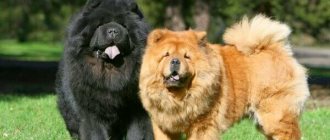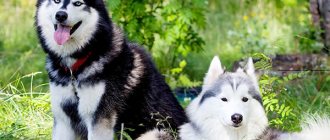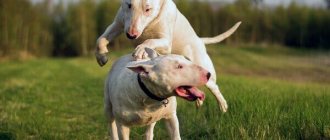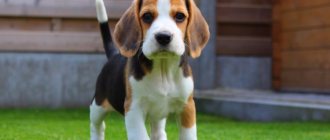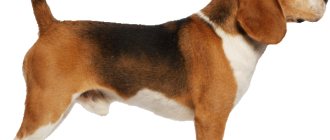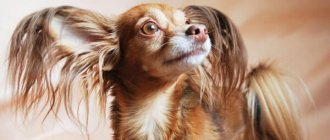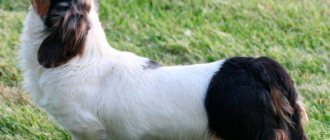- Dogs
| Data from users of the site pets-mf.ru | ||||||||||||
| Age (months) | 1 | 2 | 3 | 4 | 5 | 6 | 7 | 8 | 9 | 10 | 11 | 12 |
| Weight, kg) | — | — | 6.4 | 13 | — | — | 24 | — | — | — | — | — |
| Height (cm) | — | — | 25 | 40 | — | — | 52 | — | — | — | — | — |
This breed is one of the most ancient. It is believed that it appeared more than 3,000 years ago in Siberia and the Far North of Russia, and belongs to the Spitz group. And such dogs were brought to Europe around the end of the 19th century. It is noteworthy that in Russia this breed was considered almost extinct, and was again brought into the country only in the 90s of the last century. According to the international classification, this breed is classified as aboriginal, or primitive, since it was practically not subjected to the intervention of breeders.
Appearance of puppies (photos)
The appearance of Samoyed puppies cannot leave anyone indifferent: they look like small polar bear cubs .
It is at the stage of choosing a puppy that many “lose their heads” and do not pay any attention to disqualifying signs, or, worse, signs of ill health.
Popular questions about the breed
Is it suitable for a family? Attitude towards children
The more loving people there are around, the better the Arctic Spitz feels. If someone cannot communicate with him now, someone else will do it.
Snow-white dogs love children. Even if the baby pulls the dog’s ears, he will not show aggression. But if the child wants to play, he will keep him company. Samoyeds especially love outdoor games. On this basis, they quickly find a common language with their young owners. And if this dog is harnessed to a sled, it is unclear who will experience greater happiness: the Samoyed or the child.
Is it suitable for living in an apartment?
Samoyeds are freedom-loving dogs. They cannot be chained. But they feel great in the enclosure. If you follow some simple rules, the Samoyed Laika can be accommodated in an apartment. Don't throw things around, keep closet doors closed, and don't forget about regular walks with your pet. Then everything will be fine. There is a small chance of possible surprises. A chewed sofa, a scratched chair, torn books. Such “sins” are not limited to Samoyed Laikas.
In apartment living, the Samoyed has an advantage over other dogs. It doesn't smell. But be prepared to collect wool around the apartment. Maybe you will have an unusual handmade decor from a part of your pet?
Who Shouldn't Own a Samoyed Husky
Despite their flexible nature and kindness, snow-white dogs are not suitable for every person. Someone who disappears all day at work should not get a Samoyed. The dog does not tolerate loneliness well. The need to be in a pack, to communicate with humans and relatives is inherent in her at the genetic level.
This dog is not suitable for people who lead a sedentary lifestyle: homebodies, the elderly, the disabled. The dog needs active walks and daily physical activity.
Boys and girls: what are the differences?
It is quite easy to distinguish a female from a male by two characteristics: collar and body type.
Males have a truly luxurious collar and, in general, the breed characteristics are more pronounced. Females have a more compact and graceful physique.
There are also behavioral differences.
NOTE!
For example, females are more suitable for family, calm people, as they have a more flexible disposition and love to spend time with children.
Males, on the contrary, gravitate towards active pastime and have a more independent disposition, which means he can become an excellent companion for an avid traveler.
How to choose?
Familiarize yourself with the characteristics of the breed in advance and, if possible, talk to real breeders. Measure your strengths - can you recreate favorable conditions for her upbringing and living?
If you answered yes to each of these questions, go to the nursery.
IMPORTANT!
A puppy should be adopted at the age of 6 months. It is then that all the features of the exterior appear.
Next, the most difficult stage awaits you - choosing a puppy.
Therefore, forcefully put aside tenderness and desires to take the first baby who ran up to your call and focus your attention on the following signs of health:
- Coat : It should be thick, shiny, clean and free of clumps. The hairs should not fall off when touched.
- Stool : take the time to wait until the puppies go to the toilet and pay attention to the shape of the stool - it should not be liquid. Also pay attention to the cleanliness of the fur around the anus.
- Eyes : normally they are clean, clear, without mucus in the tear ducts.
- Ears : clean, without odor and without redness, scratches or discharge.
- Activity : the puppy must be active and cheerful, slight “childish” clumsiness is acceptable.
To prevent moving to a new place from being too stressful for your puppy, prepare your home in advance: buy bedding with thick fabric to minimize the likelihood of fleas breeding, get dishes and toys.
Also be sure to control your behavior, namely:
- Lift the puppy correctly, with both hands: place one under the chest, the other under the hips. You should not lift him by the scruff of the neck, much less pull him by the paws and tail. Also place it on the floor very carefully.
- Control your actions - do not play tug of war with the puppy - this can ruin the bite. Also, do not rub the puppy between the ears - this can ruin their shape.
- Check your puppy's health regularly and treat it for internal and external parasites.
- Do not bathe your puppy: this can disrupt the structure of his coat and cause a cold.
Story
The origin of the Samoyed breed is associated with nomadic tribes living in the northern part of Russia. The inhabitants of the tribe were engaged in hunting and fishing, and raised deer. The dogs of this tribe helped people in everyday life, transporting goods, protected them and took part in hunting.
Harsh living conditions had a positive impact on the unpretentiousness of the breed and its sociable attitude towards surrounding subjects.
The migration of tribes, like the origin of the breed, began about 3000 years ago and lasted one millennium.
Subsequently, Samoyed huskies spread to other northern peoples, and became a separate group only in the 19th century thanks to the British zoologist Ernst Kilburn-Scott.
In 1889, he spent several months among the Samoyed tribes and brought back 2 puppies, which became the founders of the Western Samoyed.
Nutrition
Samoyeds love to eat. The Samoyed husky puppy eats twice a day in large portions. Samoyeds also drink a lot, so they should always have access to clean water. It is easier to feed with premium food for medium-sized dogs - this brand is usually recommended by breeders.
It is much more difficult to feed with natural food. 70 percent of the diet should be lean meat of turkey, chicken, and rabbit. It is important to add cereals to it: buckwheat, millet, oats. Raw vegetables in the form of cabbage, carrots, pumpkins, cucumbers, lettuce, and zucchini are also added there.
The lack of calcium must be replenished with fermented milk products: cottage cheese, sugar-free yogurt, kefir, whey, yogurt. Give fish once a week, but only sea fish. Also once a week - one raw egg.
Semi-cooked by-products. For adult dogs, a single meal is sufficient, but it must fully meet the daily need for vitamins, minerals and proteins.
Samoyeds are naturally healthy
Health
Samoyeds are healthy dog breeds, but a lot will depend on the breeders from whom you are going to purchase a Samoyed puppy.
The cost of a dog in kennels, as a rule, is higher than that of amateur breeders, however, the risks associated with the dog’s health and its mental deviations are reduced. On average, Samoyeds live 12-15 years.
- Newfoundland - history of the breed, education, care + 73 photos
Chihuahua - history of the breed, description, temperament, attitude towards people and animals, care + 92 photos
Brussels Griffon - history, modern appearance, standards, character and content + 77 photos
The breed is characterized by a number of diseases that are worth paying attention to, regardless of the choice of manufacturer:
- ophthalmological diseases - cataracts, dysplasia and progressive atrophy of the retina, glaucoma;
- endocrine diseases - hypothyroidism, diabetes;
- cardiovascular diseases – aortic stenosis
- other diseases - arthritis, congenital deafness, hip dysplasia, renal dysplasia, congenital portosystemic shunt.
Interesting Facts
Friendliness, agreeableness and love for children, inherent at the genetic level, make these dogs indispensable for canistherapy. Thanks to communication with dogs, sick and disabled children begin to recover and recover faster. Parents and doctors often compare this process to a miracle.
Due to their highly developed intelligence and increased sensitivity, Samoyeds are kept in some psychiatric hospitals as four-legged doctors. They are sensitive to the human condition. Capable of getting people out of depression.
In addition, Samoyeds are able to detect the deterioration of a person’s physical condition by the first symptoms: a sharp rise in blood sugar, a hypertensive crisis, an epileptic attack.
Content Tips
If you are planning to get a Samoyed, you will have to acquire some items. Caring for a Samoyed is not an easy task. So, you will need:
- bowls for food and water;
- collar, long and short leashes, muzzle. Note that a muzzle is not only for the safety of surrounding people and animals, but also of the dog itself. You need to learn to wear a muzzle from adolescence;
- a furminator and a regular wide-tooth comb, shampoo and conditioner, and leave-in shampoo;
- if the dog will be kept in the house, then it will need a warm sleeping place, and if in an enclosure, a comfortable kennel;
- Samoyed toys;
- diapers and special panties for the bitch during heat.
Related article: How to distinguish a husky from a malamute and a samoyed
If you are buying shampoo for a small Samoyed, then give preference to detergent specifically for puppies. There is also a special whitening shampoo that will help maintain the snow-white coat of Samoyed Huskies. If your dog gets very dirty during a walk, use a super-cleansing shampoo.
It would be nice to hang a tag with your home address and a glowing keychain on the collar. Doing everything to prevent your four-legged friend from getting lost is also care.
Pros and cons of industrial feeds, wet or dry, classes
Advantages of artificial feed:
- You don't have to prepare the food yourself;
- The food is already balanced in advance, there is no need to buy additional vitamins;
- You can choose a line specifically for your pet, because the production of artificial food is diverse;
- Easy to take with you on the road if you're going on vacation or moving;
- Sometimes it can be cheaper than natural.
Disadvantages of artificial feeds:
- You will not have 100% confidence that the composition indicated on the package matches the contents;
- If the food is chosen incorrectly, the dog may develop an allergy;
- Cheap food contains low-quality products, which can cause health problems for the dog;
- Also, artificial food contains emulsifiers, preservatives, dyes and flavors;
- The vitamins contained in such food can be destroyed because it is cooked at high temperatures.
Wet food is more nutritious than dry food . They also do not contain additives, they are closest to the natural composition.
But, if compared with dry, then dry is more practical - it does not spoil, and also helps prevent tartar in dogs. It is up to the owner to decide which food is more convenient; he should also focus on the needs of the pet.
There are the following classes of feed:
- Economy _ The share of protein is achieved by adding corn, soybeans, beans, potatoes, etc. There is no meat in this food at all. It is flavored with flavors and additives, so dogs eat them with pleasure. If you use this food often, it causes allergies and diseases.
- Premium . This food maintains the most normal ratio of price and quality. These foods are the most popular. They contain by-products, but also soy. Preservatives are also added to premium food.
- Super premium . Such food already contains complete vitamins, and most importantly, meat: beef, turkey, chicken, veal, fish. You can also see vegetables and grains in the composition. Preservatives in this food are natural.
- Holistic . The highest class of feed, it is called “biologically appropriate”. All products are made from environmentally friendly ingredients. You won't find any grains in the composition; all the fiber comes from vegetables, fruits and medicinal plants. Such feeds have the highest percentage of absorption.
Character and temperament
As the breeders assure, Samoyeds have an exceptionally pleasant character: it is easy to get along with them and find a common language.
Let's highlight the main distinctive features:
- Kindness : The Samoyed is overly affectionate and friendly. He can find an approach to any family member, including very young children. He is not characterized by aggression or hunting instinct, so he easily gets along with other animals. Due to its highly social adaptation, the dog is not at all suitable for protection.
- Trainability : The Samoyed loves to exercise. He likes to please and please his master, although sometimes he can be stubborn in order to test the “limits of what is permitted.” The fox dog is smart and cunning, has a good sense of mood and knows how to manipulate.
- Loyalty : very attached to all members of his family, but only one is chosen as the “leader of the pack”. For this reason, dog experts do not recommend getting an adult dog.
- Contact : loves to be the center of attention. Loves to lick people and jump into people's arms to show affection. For this reason, they should not be left alone for long. Ideally, at least one family member will be at home on a permanent basis. Otherwise, the Samoyed will begin to get nervous and worry about his loved one and “chew” his stress with furniture or shoes. This breed is definitely not suitable for people who are too busy.
- Energy : This is a very active and lively dog that simply needs to walk for several hours in the fresh air. In addition, Samoyeds are adapted to life on the street, but for harmonious development they need a large space. A kennel or chain harness will not work - you need a spacious enclosure.
- Endurance . This point directly follows from the previous one. Samoyeds can play tirelessly for several hours, so the future owner needs to review his daily schedule in advance and purchase a sufficient number of toys.
- Talkativeness . Samoyeds love to communicate with their owner and love the sound of their own voice even more. That is why they accompany each of their actions with a characteristic guttural whine or short bark.
- Love of life : they do not lose their puppyish delight, adventurism and thirst for adventure until old age.
What is the price?
As for pricing, the final cost is determined depending on several components: the purity of the breed, club and class.
Eg:
- Puppies without a brand do not participate in breeding. Average price from 8 to 15 thousand rubles
- Breed class (most often used in breeding). The average price is from 25 to 35 thousand rubles.
- Show class - the dog meets 100% standard characteristics. This option is suitable for those who want their dog to participate in exhibitions and receive titles. The most expensive option of all is from 35 to 65 thousand rubles.
Main types of colors
White is the canonical color for the Samoyed.
Few people know, but the standard includes two more colors. Let's look at each in a little more detail :
- White . Looking at a white Samoyed, one would like to call it snow-white - its fur reflects sunlight and sparkles beautifully. This effect is created thanks to the translucent tips of the guard hairs.
- Cream . The wool has a pleasant, warm tint. A dog with this color looks attractive, but has much less chance at an exhibition than a snow-white individual.
- White with biscuit spots . The rarest color. The predominant mass of the fur is snow-white, and only some areas are chaotically colored in a pale, biscuit shade.
Yellowing of the Samoyed's white coat may be a sign of improper grooming , illness, or an excess of animal proteins in the dog's diet.
Sometimes black Samoyeds are also found, but this coat color is not recognized by the breed standard.
What varieties are there?
There are only two types of rock, which differ slightly in their structure:
- Bearish: short and powerful, stocky body, and wide skull. So named because of its resemblance to a teddy bear.
- Wolf: elongated, lean body, narrow skull. They look more graceful and fragile than their bear-type counterparts.
